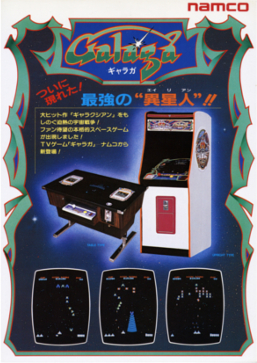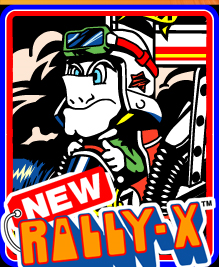
Pac-Man, originally called Puck Man in Japan, is a 1980 maze video game developed and released by Namco for arcades. In North America, the game was released by Midway Manufacturing as part of its licensing agreement with Namco America. The player controls Pac-Man, who must eat all the dots inside an enclosed maze while avoiding four colored ghosts. Eating large flashing dots called "Power Pellets" causes the ghosts to temporarily turn blue, allowing Pac-Man to eat them for bonus points.

Ms. Pac-Man is a 1982 maze arcade video game developed by General Computer Corporation and published by Midway. It is a spin-off sequel to Pac-Man (1980) and the first entry in the series to not be made by Namco. Controlling the title character, Pac-Man's wife, the player is tasked with eating all of the pellets in an enclosed maze while avoiding four colored ghosts. Eating the larger "power pellets" lets the player eat the ghosts, which turn blue and flee.

Galaga is a 1981 fixed shooter arcade video game developed and published by Namco. In North America, it was released by Midway Manufacturing. It is the sequel to Galaxian (1979), Namco's first major video game hit in arcades. Controlling a starship, the player is tasked with destroying the Galaga forces in each stage while avoiding enemies and projectiles. Some enemies can capture a player's ship via a tractor beam, which can be rescued to transform the player into a "dual fighter" with additional firepower.

Dig Dug is a maze arcade video game released by Namco in 1982. It was distributed in North America by Atari, Inc. The player digs underground tunnels to attack enemies in each level, by either inflating them to bursting or crushing them underneath rocks.

Pac-Land is a 1984 side-scrolling arcade platform game developed and released by Namco. It was distributed in North America by Bally Midway, and in Europe by Atari Games. Controlling Pac-Man, the player must make it to the end of each stage to return a lost fairy back to its home in Fairyland. Pac-Man will need to avoid obstacles, such as falling logs and water-spewing fire hydrants, alongside his enemies, the Ghost Gang. Eating large flashing Power Pellets will cause the ghosts to turn blue, allowing Pac-Man to eat them for points.

Super Pac-Man is a 1982 maze chase arcade game developed and published by Namco. It was distributed in North America by Midway, and is Namco's take on a sequel to the original Pac-Man; Midway had previously released Ms. Pac-Man, which Namco had little involvement with. Toru Iwatani returns as designer.
Namco Museum is a series of video game compilations developed and published by Bandai Namco Entertainment for home video game consoles. The first title in the series, Namco Museum Vol. 1, was released for the PlayStation in 1995. Entries in the series have been released for multiple platforms, including the Game Boy Advance, PlayStation 2, PlayStation Portable, Nintendo DS and Xbox 360. the latest being Namco Museum Archives Vol. 2, released in 2020.

Galaga '88 is a 1987 fixed shooter arcade video game developed and published in Japan by Namco and in North America and Europe by Atari Games. It is the third sequel to Galaxian. It features significantly improved graphics over the previous games in the series, including detailed backgrounds, larger enemies and greater ship details. The game runs on Namco System 1 hardware.

New Rally-X is a maze chase arcade video game released by Namco in 1981. It is a lightly tweaked version of 1980's Rally-X, with slightly enhanced graphics, easier gameplay, a new soundtrack, and a "Lucky Flag" that gives the player extra points for remaining fuel when collected.

Pac & Pal is a 1983 maze chase arcade game developed and published by Namco. It is part of the company's Pac-Man series and the third to have been produced in-house. Players control Pac-Man as he must eat the items in an enclosed maze while avoiding four colored ghosts that pursue him. Pac-Man is assisted by a green-colored creature named Miru, the titular "Pal", who brings the items back to the center box. Pac-Man can also collect power-ups that allow him to briefly stun the ghosts.

Grobda is a 1984 multidirectional shooter arcade video game developed and published by Namco. It is a spin-off from Xevious, as the player's tank first appeared in that game as an enemy. It runs on Namco Super Pac-Man hardware but with a video system like that used in Mappy and The Tower of Druaga, and it also uses a DAC for the "Get Ready" speech sample at the start of each round.

Dragon Spirit is a 1987 vertical-scrolling shooter arcade game developed and published by Namco. In North America, it was distributed by Atari Games. Controlling the dragon Amur, the player must complete each of the game's nine areas to rescue the princess Alicia from the demon Zawell. Similar to Namco's own Xevious, Amur has a projectile weapon for destroying air-based enemies and a bomb for destroying ground enemies. It ran on the Namco System 1 arcade board.

Genpei Tōma Den is a side-scrolling hack and slash video game produced by Namco that was released as a coin-operated video game in 1986 in Japan. It runs on Namco System 86 hardware. Over a decade later, the game was released in America and Europe in the video game compilation Namco Museum Vol. 4 under the title of The Genji and the Heike Clans for the PlayStation.

Tinkle Pit is a maze arcade game released by Namco in 1993 only in Japan. It features many of the characters from the company's earlier games.

Namco Classic Collection Vol. 2 is a 1996 compilation arcade game developed and published by Namco. It is a collection of four of Namco's popular games: Pac-Man (1980), Rally-X (1980), New Rally-X (1981) and Dig Dug (1982). Alongside the original games, three new "Arrangement" games based on each game are included.

Cutie Q is a 1979 block breaker/video pinball hybrid arcade game developed and published by Namco in Japan. The player controls a set of paddles with a rotary knob, the objective being to score as many points possible by deflecting a ball against blocks, ghosts, spinners and other objects on the playfield. It was designed by Shigeru Yokoyama, with spritework done by Toru Iwatani. It is the third and final game in the Gee Bee trilogy.

Head On is an arcade video game developed by Sega/Gremlin and released by Sega in 1979. It was the first maze video game where the goal is to run over dots. Designed by Lane Hauck at Sega/Gremlin in the United States, it was the fourth highest-grossing arcade game of 1979 in both Japan and the US.

Quester is a 1987 block breaker arcade game developed and published in Japan by Namco. Controlling a paddle-like craft, the player is tasked with clearing each stage by deflecting a ball towards a formation of bricks towards the top of the screen. Power-up items are hidden in some blocks, which can increase the size of the player's paddle, a barrier that prevents the ball from moving off the screen, and a forcefield that will release eight other balls when touched.


















